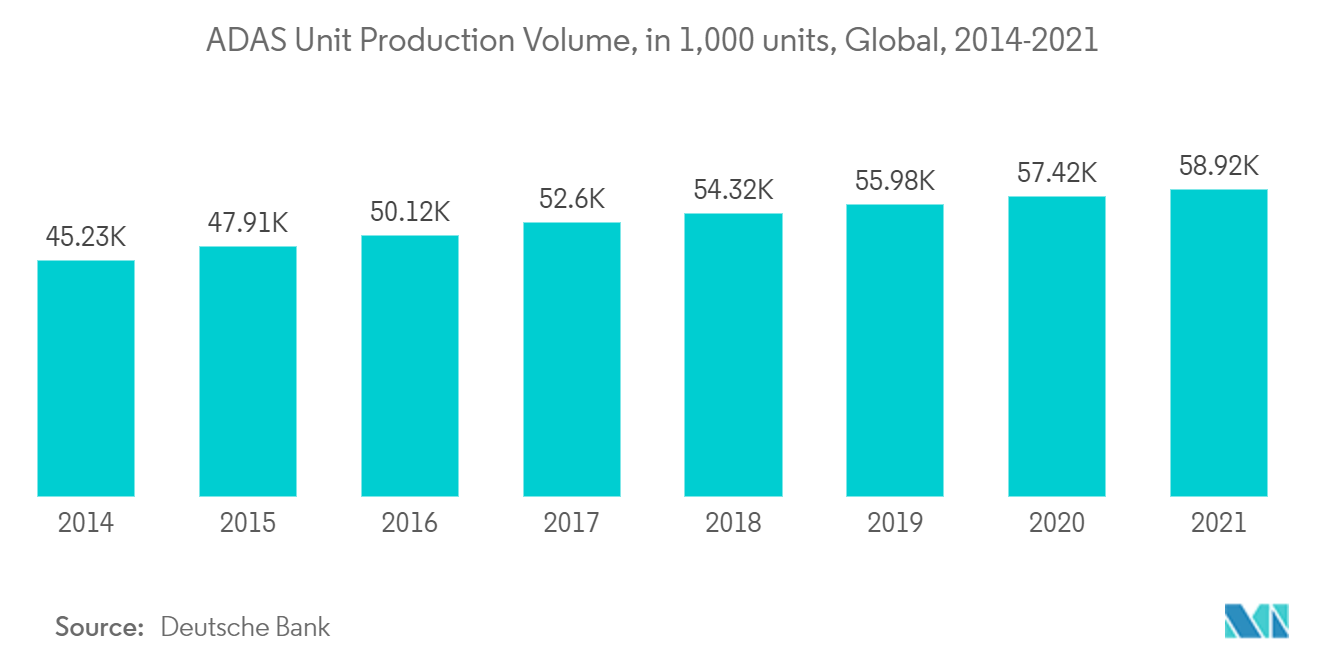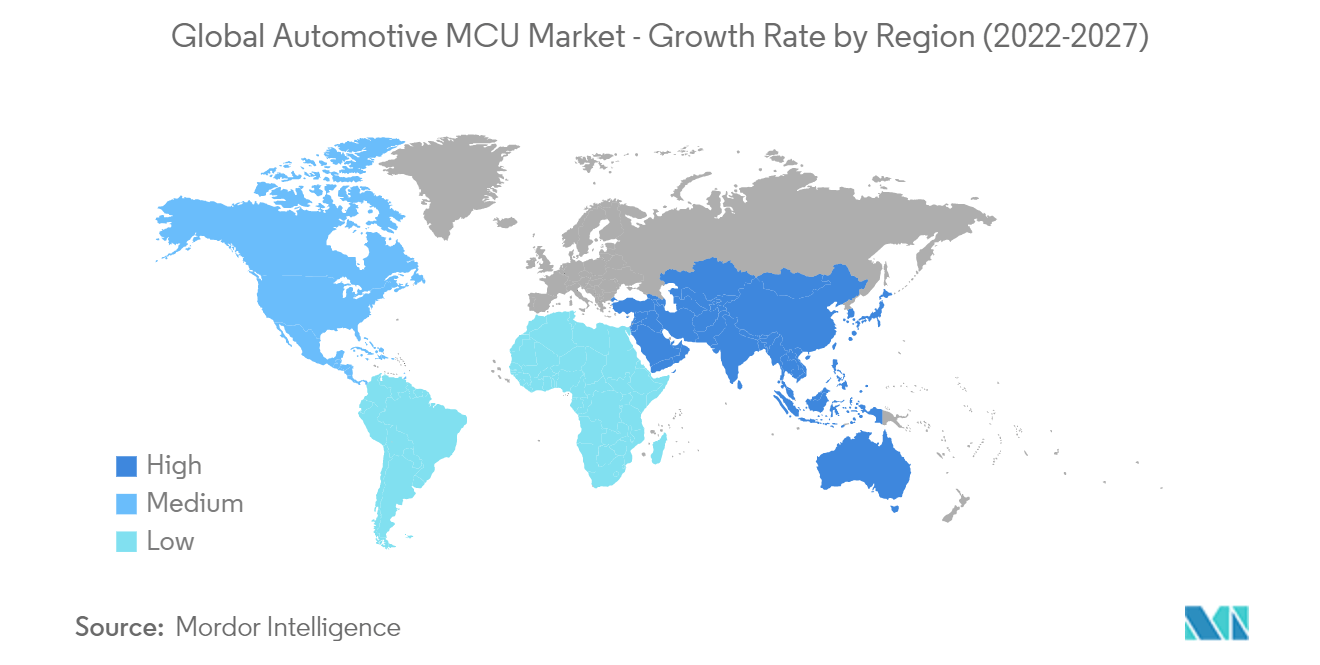Market Trends of Global Automotive MCU Industry
This section covers the major market trends shaping the Automotive MCU Market according to our research experts:
Surging Demand for ADAS is Likely to Drive the Market Growth
- According to World Health Organization (WHO), approximately 1.3 million people die each year due to road traffic crashes which cost most countries approximately 3% of their gross domestic product (GDP). Further, according to Safe International Road Travel, more than 46,000 people die in crashes on U.S. roadways every year. The U.S. traffic fatality rate is 12.4 deaths per 100,000 inhabitants. An additional 4.4 million are injured seriously enough to require medical attention. Road crashes are the leading cause of death in the U.S. for people aged 1-54. Also, the U.S. suffers the most road crash deaths of any high-income country, about 50% higher than similar countries in Western Europe, Canada, Australia, and Japan.
- Vehicles installed with Advanced Driver Assistance Systems (ADAS) can detect and classify objects on the road and alert drivers according to the road conditions. Additionally, these systems can automatically decelerate vehicles, depending on the situation. A few essential safety-critical ADAS applications include pedestrian detection/avoidance, lane departure warning/correction, traffic sign recognition, automatic emergency braking, blind-spot detection, etc. These lifesaving systems are crucial to ensuring the success of ADAS applications, incorporating the latest interface standards, and running multiple vision-based algorithms to support real-time multimedia, vision co-processing, and sensor fusion subsystems.
- According to National Safety Council, ADAS technologies have the potential to prevent 20,841 deaths per year, or about 62% of total traffic deaths. The emergence of advanced driver assistance systems (ADAS) is changing how designers use, specify, and manufacture microcontrollers (MCUs). The evolving and complex nature of ADAS is expected to offer several opportunities for innovation, collaborations, and technological breakthroughs in the studied market.
- For instance, in April 2022, SemiDrive Technology Ltd., a Chinese smart car microchip designer, released its E3 series microcontrollers. The automotive microcontroller adopts a TSMC 22nm automotive grade which can be used in many automotive application fields such as chassis by wire, brake control, BMS, ADAS, LCD panel, HUD, streaming media system, and CMS, among others. It is designed to reach high stability and safety levels. Its vehicle specification is AEC-Q100 Grade 1, and the functional safety standard is ISO 26262 ASIL D.
- Moreover, in March 2022, Renesas Electronics, a supplier of advanced semiconductor solutions, announced the expansion of its collaboration with Honda in the field of advanced driver-assistance systems (ADAS). Honda adopted Renesas' R-Car automotive system on a chip (SoC) and RH850 automotive MCU for its Honda SENSING Elite system. Honda SENSING Elite (featured in the Legend, which went on sale in March 2021) incorporates advanced technology that qualifies for Level 3 automated driving (conditional automated driving in limited areas). Further, Honda has selected R-Car and RH850 for use in the Honda SENSING 360 omnidirectional safety and driver assistance system, which builds on the knowledge and expertise gained through research and development work on the earlier technology.

The Asia Pacific Region is Expected to Witness a High Market Growth
- The growing environmental concerns and rising government subsidy programs, coupled with factors such as better fuel economy, enhanced performance, and reasonable cost, are augmenting the penetration rate of hybrid electric vehicles in the Asia-Pacific region.
- For instance, according to EV-Volumes.com, approximately 672.9 thousand plug-in hybrid electric vehicles (PHEVs) were sold across the Asia-Pacific region in 2021. This was a dramatic increase from 2020 when around 264.26 thousand plug-in hybrid electric vehicles were sold. The increasing demand for these vehicles is likely to boost the maker growth of automotive MCUs in the region.
- Further, the Asia Pacific has emerged as a significant hub for manufacturing semiconductors and semiconductor-based devices. For instance, according to World Semiconductor Trade Statistics (WSTS) estimates, the semiconductor industry revenue in the Asia Pacific region (excluding Japan) was USD 257.88 billion in 2019 and USD 290.85 billion in 2021. The region is also home to prominent electronics and automotive manufacturing companies, thus, offering scope for the evolution of the studied market.
- The future of automotive system design lies in a vehicle-centralized, zone-oriented E/E architecture, which heightens the need for automotive chips that address the challenges these innovative architectures create for future vehicle generations. The companies in the region are launching advanced solutions to cater to the needs of their consumers.
- For instance, in November 2021, Renesas Electronics Corporation (Tokyo, Japan) introduced a powerful new group of microcontrollers (MCUs), the RH850/U2B MCUs, designed to address the growing need to integrate multiple applications into a single chip and realize a unified electronic control unit (ECU) for the evolving electrical-electronic (E/E) architecture. Delivering a combination of flexibility, high performance, freedom from interference, and security, the cross-domain RH850/U2B MCUs are built for the rigorous workloads required by vehicle motion in terms of hybrid ICE and xEV traction inverter, connected gateway, high-end zone control, and domain control applications.


